Lenovo M600 User Manual

ThinkCentre M600
User Guide
Machine Types: 10G8, 10G9, 10GA, 10GB, 10GC, 10GD, 10GE, 10GF, 10KG, 10KH, 10KJ, and 10KK
Note: Before using this information and the product it supports, be sure to read and understand the “Read this first: Important safety information” on page iii and Appendix F “Notices” on page 115.
Second Edition (January 2016)
© Copyright Lenovo 2015, 2016.
LIMITED AND RESTRICTED RIGHTS NOTICE: If data or software is delivered pursuant a General Services Administration “GSA” contract, use, reproduction, or disclosure is subject to restrictions set forth in Contract No. GS-35F-05925.

Contents
Read this first: Important safety |
|
information . . . . . . . . . . . . . . |
iii |
Before using this manual. . . . . . . . . . . . |
iii |
Service and upgrades . . . . . . . . . . . . . |
iii |
Static electricity prevention. . . . . . . . . . . |
iv |
Power cords and power adapters . . . . . . . . |
iv |
Extension cords and related devices . . . . . . . |
v |
Plugs and outlets. . . . . . . . . . . . . . . |
v |
External devices . . . . . . . . . . . . . . . |
v |
Heat and product ventilation . . . . . . . . . . |
v |
Operating environment . . . . . . . . . . . . |
vi |
Laser compliance statement . . . . . . . . . . |
vi |
Power supply statement . . . . . . . . . . . |
vii |
Cleaning and maintenance . . . . . . . . . . |
vii |
Chapter 1. Product overview . . . . . . |
1 |
Hardware locations . . . . . . . . . . . . . . |
1 |
Front view. . . . . . . . . . . . . . . . |
1 |
Rear view . . . . . . . . . . . . . . . . |
3 |
Computer components . . . . . . . . . . |
5 |
Parts on the system board . . . . . . . . . |
7 |
Machine type and model label. . . . . . . . |
8 |
Features . . . . . . . . . . . . . . . . . . |
8 |
Specifications . . . . . . . . . . . . . . . |
11 |
Programs . . . . . . . . . . . . . . . . . |
11 |
Accessing a program on your computer . . . |
11 |
Installing a program that is ready to be |
|
installed . . . . . . . . . . . . . . . |
12 |
An introduction to Lenovo programs . . . . |
12 |
Chapter 2. Using your computer . . . |
15 |
Registering your computer . . . . . . . . . . |
15 |
Setting the computer volume . . . . . . . . . |
15 |
Adding an icon to the Windows notification area . |
15 |
Using a disc. . . . . . . . . . . . . . . . |
16 |
Guidelines about using the optical drive . . . |
16 |
Handling and storing a disc . . . . . . . . |
16 |
Playing and removing a disc . . . . . . . |
16 |
Recording a disc . . . . . . . . . . . . |
17 |
Connecting to a network . . . . . . . . . . . |
17 |
Connecting to an Ethernet LAN . . . . . . |
17 |
Connecting to a wireless LAN . . . . . . . |
18 |
Connecting to a Bluetooth-enabled device . . |
18 |
I/O box. . . . . . . . . . . . . . . . . . |
18 |
About the I/O box. . . . . . . . . . . . |
18 |
Using the I/O box . . . . . . . . . . . . |
19 |
External battery box . . . . . . . . . . . . |
19 |
Battery safety information . . . . . . . . |
19 |
Using the external battery kit . . . . . . . |
20 |
Chapter 3. You and your computer . |
. |
23 |
Arranging your workspace . . . . . . . . . |
. |
23 |
Glare and lighting . . . . . . . . . . . |
. |
23 |
Air circulation . . . . . . . . . . . . |
. |
23 |
Electrical outlet locations and cable lengths |
. |
23 |
Comfort . . . . . . . . . . . . . . |
. |
23 |
Accessibility information . . . . . . . . . . |
. |
24 |
Cleaning your computer . . . . . . . . . . |
. |
27 |
Maintenance . . . . . . . . . . . . . . |
. |
27 |
Basic maintenance tips . . . . . . . . |
. |
27 |
Good maintenance practices . . . . . . |
. |
27 |
Keeping your computer current . . . . . |
. |
28 |
Moving your computer . . . . . . . . . . |
. |
29 |
Chapter 4. Security . . . . . . . . . . |
31 |
Locking your computer . . . . . . . . . . . |
31 |
Locking the computer cover . . . . . . . |
31 |
Attaching a Kensington-style cable lock . . . |
33 |
Viewing and changing security settings in the |
|
Setup Utility program . . . . . . . . . . . . |
33 |
Preventing unauthorized access to your |
|
computer . . . . . . . . . . . . . . . . . |
33 |
Using fingerprint authentication . . . . . . . . |
34 |
Using and understanding firewalls . . . . . . . |
34 |
Protecting data against viruses . . . . . . . . |
34 |
Computrace Agent software embedded in |
|
firmware . . . . . . . . . . . . . . . . . |
35 |
Trusted Platform Module (TPM) . . . . . . . . |
35 |
Chapter 5. Advanced configuration . . |
37 |
Using the Setup Utility program . . . . . . . . |
37 |
Starting the Setup Utility program . . . . . |
37 |
Enabling or disabling a device . . . . . . . |
37 |
Enabling or disabling the Automatic Power On |
|
features . . . . . . . . . . . . . . . |
37 |
Enabling or disabling ErP LPS compliance |
|
mode . . . . . . . . . . . . . . . . |
38 |
Enabling or disabling the Configuration |
|
Change Detection feature . . . . . . . . |
38 |
Using the cover presence switch. . . . . . |
39 |
Using BIOS passwords . . . . . . . . . |
39 |
Selecting a startup device . . . . . . . . |
40 |
Exiting the Setup Utility program . . . . . . |
41 |
Updating the BIOS . . . . . . . . . . . . . |
41 |
© Copyright Lenovo 2015, 2016 |
i |
Chapter 6. Troubleshooting, |
|
diagnostics, and recovery . . . . . . |
43 |
Basic procedure for resolving computer |
|
problems . . . . . . . . . . . . . . . . . |
43 |
Troubleshooting . . . . . . . . . . . . . . |
43 |
Startup problems . . . . . . . . . . . . |
43 |
Audio problems . . . . . . . . . . . . |
44 |
CD problems . . . . . . . . . . . . . |
45 |
DVD problems . . . . . . . . . . . . . |
45 |
Intermittent problems . . . . . . . . . . |
46 |
Storage drive problems . . . . . . . . . |
46 |
Networking problems . . . . . . . . . . |
47 |
Performance problems. . . . . . . . . . |
49 |
Serial connector cannot be accessed . . . . |
50 |
USB device problems . . . . . . . . . . |
50 |
Software and driver problems . . . . . . . |
50 |
Diagnostics . . . . . . . . . . . . . . . . |
51 |
Lenovo Solution Center . . . . . . . . . |
51 |
Recovery information . . . . . . . . . . . . |
51 |
Recovery information for Windows 7 . . . . |
51 |
Recovery information for Windows 10. . . . |
53 |
Chapter 7. Installing or replacing |
|
hardware . . . . . . . . . . . . . . . |
55 |
Handling static-sensitive devices . . . . . . . |
55 |
Installing or replacing hardware . . . . . . . . |
55 |
Installing external options . . . . . . . . |
55 |
Replacing the power adapter . . . . . . . |
56 |
Replacing the vertical stand. . . . . . . . |
57 |
Replacing the VESA mount bracket. . . . . |
59 |
Replacing the external optical drive (for 10G8, |
|
10G9, 10GA, 10GB, 10GC, 10GD, 10GE, and |
|
10GF) . . . . . . . . . . . . . . . . |
61 |
Replacing the I/O box (for 10G8, 10G9, 10GA, |
|
10GB, 10GC, 10GD, 10GE, and 10GF) . . . |
67 |
Replacing the external battery box (for 10G8, |
|
10G9, 10GA, 10GB, 10GC, 10GD, 10GE, and |
|
10GF) . . . . . . . . . . . . . . . . |
70 |
Replacing the power adapter bracket . . . . |
74 |
Removing the computer cover. . . . . . . |
76 |
Replacing the system fan (for 10G8, 10G9, |
|
10GA, 10GB, 10GC, 10GD, 10GE, and |
|
10GF) . . . . . . . . . . . . . . . . |
78 |
Replacing the heat sink . . . . . . . . . |
80 |
Replacing the memory module . . . . . . |
82 |
Replacing the internal speaker. . . . . . . |
84 |
Replacing the storage drive . . . . . . . . |
86 |
Replacing the coin-cell battery . . . . . . |
90 |
Replacing the Wi-Fi card . . . . . . . . . |
92 |
Completing the parts replacement . . . . . |
93 |
Chapter 8. Getting information, help, |
|
and service . . . . . . . . . . . . . . |
97 |
Information resources . . . . . . . . . . . . |
97 |
Accessing the user guide in various |
|
languages. . . . . . . . . . . . . . . |
97 |
Windows help system . . . . . . . . . . |
97 |
Safety and warranty . . . . . . . . . . . |
97 |
Lenovo Web site . . . . . . . . . . . . |
97 |
Lenovo Support Web site. . . . . . . . . |
98 |
Frequently asked questions . . . . . . . . |
98 |
Help and service . . . . . . . . . . . . . . |
98 |
Calling for service. . . . . . . . . . . . |
98 |
Using other services . . . . . . . . . . |
99 |
Purchasing additional services . . . . . . |
99 |
Appendix A. Regulatory |
|
information . . . . . . . . . . . . . |
101 |
Export classification notice . . . . . . . . . . |
101 |
Electronic emissions notices . . . . . . . . . |
101 |
Federal Communications Commission |
|
Declaration of Conformity . . . . . . . . |
101 |
Eurasian compliance mark . . . . . . . . . . |
103 |
Brazil audio notice . . . . . . . . . . . . . |
103 |
Mexico wireless-radio compliance information . . |
103 |
Additional regulatory information . . . . . . . |
103 |
Appendix B. WEEE and recycling |
|
information . . . . . . . . . . . . . |
105 |
Important WEEE information . . . . . . . . . |
105 |
Recycling information for Japan . . . . . . . . |
105 |
Recycling information for Brazil . . . . . . . . |
106 |
Battery recycling information for Taiwan . . . . . |
106 |
Battery recycling information for the European |
|
Union . . . . . . . . . . . . . . . . . . |
106 |
Appendix C. Restriction of Hazardous Substances Directive (RoHS) . . . . 109
European Union RoHS . . . . . . . . . . . |
109 |
China RoHS. . . . . . . . . . . . . . . . |
109 |
Turkish RoHS . . . . . . . . . . . . . . . |
109 |
Ukraine RoHS . . . . . . . . . . . . . . . |
110 |
India RoHS . . . . . . . . . . . . . . . . |
110 |
Appendix D. China Energy Label . . 111
Appendix E. ENERGY STAR model information . . . . . . . . . . . . . 113
Appendix F. Notices . . . . . . . . . 115
Trademarks . . . . . . . . . . . . . . . . 116
ii ThinkCentre M600 User Guide

Read this first: Important safety information
This chapter contains the safety information that you must be familiar with.
Before using this manual
CAUTION:
Before using this manual, be sure to read and understand all the related safety information for this product. Refer to the information in this section and the safety information in the Safety, Warranty, and Setup Guide that you received with this product. Reading and understanding this safety information reduces the risk of personal injury and damage to your product.
If you no longer have a copy of the Safety, Warranty, and Setup Guide, you can obtain a Portable Document Format (PDF) version from the Lenovo® Support Web site at http://www.lenovo.com/UserManuals. The Lenovo Support Web site also provides the Safety, Warranty, and Setup Guide and this User Guide in additional languages.
Service and upgrades
Do not attempt to service a product yourself unless instructed to do so by the Customer Support Center or your documentation. Only use a Service Provider who is approved to repair your particular product.
Note: Some computer parts can be upgraded or replaced by the customer. Upgrades typically are referred to as options. Replacement parts approved for customer installation are referred to as Customer Replaceable Units, or CRUs. Lenovo provides documentation with instructions when it is appropriate for customers to install options or replace CRUs. You must closely follow all instructions when installing or replacing parts. The Off state of a power indicator does not necessarily mean that voltage levels inside a product are zero. Before you remove the covers from a product equipped with a power cord, always ensure that the power is turned off and that the product is unplugged from any power source. For more information on CRUs, refer to Chapter 7 “Installing or replacing hardware” on page 55. If you have any questions or concerns, contact the Customer Support Center.
Although there are no moving parts in your computer after the power cord has been disconnected, the following warnings are required for your safety.
CAUTION:
Hazardous moving parts. Keep fingers and other body parts away.
CAUTION:
Before you open the computer cover, turn off the computer and wait several minutes until the computer is cool.
© Copyright Lenovo 2015, 2016 |
iii |

Static electricity prevention
Static electricity, although harmless to you, can seriously damage computer components and options. Improper handling of static-sensitive parts can cause damage to the part. When you unpack an option or CRU, do not open the static-protective package containing the part until the instructions direct you to install it.
When you handle options or CRUs, or perform any work inside the computer, take the following precautions to avoid static-electricity damage:
•Limit your movement. Movement can cause static electricity to build up around you.
•Always handle components carefully. Handle adapters, memory modules, and other circuit boards by the edges. Never touch exposed circuitry.
•Prevent others from touching components.
•When you install a static-sensitive option or CRU, touch the static-protective package containing the part to a metal expansion-slot cover or other unpainted metal surface on the computer for at least two seconds. This reduces static electricity in the package and your body.
•When possible, remove the static-sensitive part from the static-protective packaging and install the part without setting it down. When this is not possible, place the static-protective packaging on a smooth, level surface and place the part on it.
•Do not place the part on the computer cover or other metal surface.
Power cords and power adapters
Use only the power cords and power adapters supplied by the product manufacturer. Do not use the ac power cord for other devices.
The power cords shall be safety approved. For Germany, it shall be H05VV-F, 3G, 0.75 mm2, or better. For other countries, the suitable types shall be used accordingly.
Never wrap a power cord around a power adapter or other object. Doing so can stress the cord in ways that can cause the cord to fray, crack, or crimp. This can present a safety hazard.
Always route power cords so that they will not be walked on, tripped over, or pinched by objects.
Protect power cord and power adapters from liquids. For instance, do not leave your power cord or power adapter near sinks, tubs, toilets, or on floors that are cleaned with liquid cleansers. Liquids can cause a short circuit, particularly if the power cord or power adapter has been stressed by misuse. Liquids also can cause gradual corrosion of power cord terminals and/or the connector terminals on a power adapter, which can eventually result in overheating.
Ensure that all power cord connectors are securely and completely plugged into receptacles.
Do not use any power adapter that shows corrosion at the ac input pins or shows signs of overheating (such as deformed plastic) at the ac input or anywhere on the power adapter.
Do not use any power cords where the electrical contacts on either end show signs of corrosion or overheating or where the power cord appears to have been damaged in any way.
iv ThinkCentre M600 User Guide

Extension cords and related devices
Ensure that extension cords, surge protectors, uninterruptible power supplies, and power strips that you use are rated to handle the electrical requirements of the product. Never overload these devices. If power strips are used, the load should not exceed the power strip input rating. Consult an electrician for more information if you have questions about power loads, power requirements, and input ratings.
Plugs and outlets
If a receptacle (power outlet) that you intend to use with your computer equipment appears to be damaged or corroded, do not use the outlet until it is replaced by a qualified electrician.
Do not bend or modify the plug. If the plug is damaged, contact the manufacturer to obtain a replacement.
Do not share an electrical outlet with other home or commercial appliances that draw large amounts of electricity; otherwise, unstable voltage might damage your computer, data, or connected devices.
Some products are equipped with a three-pronged plug. This plug fits only into a grounded electrical outlet. This is a safety feature. Do not defeat this safety feature by trying to insert it into a non-grounded outlet. If you cannot insert the plug into the outlet, contact an electrician for an approved outlet adapter or to replace the outlet with one that enables this safety feature. Never overload an electrical outlet. The overall system load should not exceed 80 percent of the branch circuit rating. Consult an electrician for more information if you have questions about power loads and branch circuit ratings.
Be sure that the power outlet you are using is properly wired, easily accessible, and located close to the equipment. Do not fully extend power cords in a way that will stress the cords.
Be sure that the power outlet provides the correct voltage and current for the product you are installing.
Carefully connect and disconnect the equipment from the electrical outlet.
External devices
Do not connect or disconnect any external device cables other than Universal Serial Bus (USB) cables while the computer power is on; otherwise, you might damage your computer. To avoid possible damage to connected devices, wait at least five seconds after the computer is shut down to disconnect external devices.
Heat and product ventilation
Computers, power adapters, and many accessories can generate heat when turned on and when batteries are charging. Always follow these basic precautions:
•Do not leave your computer, power adapter, or accessories in contact with your lap or any part of your body for an extended period when the products are functioning or when the battery is charging. Your computer, power adapter, and many accessories produce some heat during normal operation. Extended contact with the body could cause discomfort or, potentially, a skin burn.
•Do not charge the battery or operate your computer, power adapter, or accessories near flammable materials or in explosive environments.
•Ventilation slots, fans, and heat sinks are provided with the product for safety, comfort, and reliable operation. These features might inadvertently become blocked by placing the product on a bed, sofa, carpet, or other flexible surface. Never block, cover, or disable these features.
© Copyright Lenovo 2015, 2016 |
v |

Inspect your desktop computer for dust accumulation at least once every three months. Before inspecting your computer, turn off the power and unplug the computer's power cord from the electrical outlet; then remove any dust from vents and perforations in the bezel. If you notice external dust accumulation, then examine and remove dust from the inside of the computer including heat sink inlet fins, power supply vents, and fans. Always turn off and unplug the computer before opening the cover. If possible, avoid operating your computer within two feet of high-traffic areas. If you must operate your computer in or near a high-traffic area, inspect and, if necessary, clean your computer more frequently.
For your safety and to maintain optimum computer performance, always follow these basic precautions with your desktop computer:
•Keep the cover closed whenever the computer is plugged in.
•Regularly inspect the outside of the computer for dust accumulation.
•Remove dust from vents and any perforations in the bezel. More frequent cleanings might be required for computers in dusty or high-traffic areas.
•Do not restrict or block any ventilation openings.
•Do not store or operate your computer inside furniture, as this might increase the risk of overheating.
•Airflow temperatures into the computer should not exceed 35°C (95°F).
•Do not install air filtration devices. They may interfere with proper cooling.
Operating environment
The optimal environment in which to use your computer is 10°C–35°C (50°F–95°F) with humidity ranging between 35% and 80%. If your computer is stored or transported in temperatures less than 10°C (50°F), allow the cold computer to rise slowly to an optimal operating temperature of 10°C–35°C (50°F–95°F) before use. This process could take two hours in extreme conditions. Failure to allow your computer to rise to an optimal operating temperature before use could result in irreparable damage to your computer.
If possible, place your computer in a well-ventilated and dry area without direct exposure to sunshine.
Keep electrical appliances such as an electric fan, radio, high-powered speakers, air conditioner, and microwave oven away from your computer because the strong magnetic fields generated by these appliances can damage the monitor and data on the storage drive.
Do not place any beverages on top of or beside the computer or other connected devices. If liquid is spilled on or in the computer or a connected device, a short circuit or other damage might occur.
Do not eat or smoke over your keyboard. Particles that fall into your keyboard can cause damage.
Laser compliance statement
CAUTION:
When laser products (such as CD-ROMs, DVD drives, fiber optic devices, or transmitters) are installed, note the following:
•Do not remove the covers. Removing the covers of the laser product could result in exposure to hazardous laser radiation. There are no serviceable parts inside the device.
•Use of controls or adjustments or performance of procedures other than those specified herein might result in hazardous radiation exposure.
vi ThinkCentre M600 User Guide
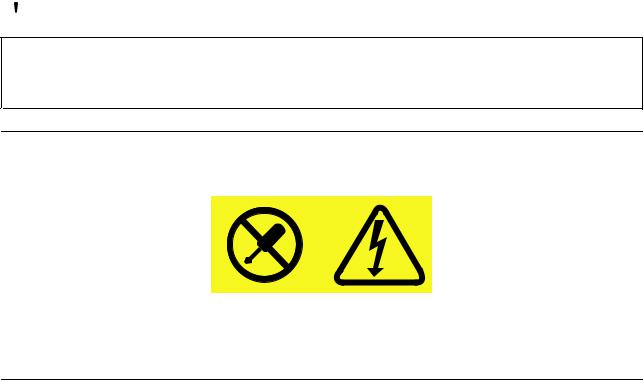
 DANGER
DANGER
Some laser products contain an embedded Class 3A or Class 3B laser diode. Note the following:
Laser radiation when open. Do not stare into the beam, do not view directly with optical instruments, and avoid direct exposure to the beam.
Power supply statement
Never remove the cover on a power supply or any part that has the following label attached.
Hazardous voltage, current, and energy levels are present inside any component that has this label attached. There are no serviceable parts inside these components. If you suspect a problem with one of these parts, contact a service technician.
Cleaning and maintenance
Keep your computer and workspace clean. Shut down the computer and then disconnect the power cord before cleaning the computer. Do not spray any liquid detergent directly on the computer or use any detergent containing flammable material to clean the computer. Spray the detergent on a soft cloth and then wipe the computer surfaces.
© Copyright Lenovo 2015, 2016 |
vii |
viii ThinkCentre M600 User Guide

Chapter 1. Product overview
This chapter provides information about the following topics:
•“Hardware locations” on page 1
•“Features” on page 8
•“Specifications” on page 11
•“Programs” on page 11
Hardware locations
This section provides information about the locations of your computer hardware.
Note: The computer hardware might look slightly different from the illustrations.
Front view
Figure 1. Front view
|
|
Power button |
|
|
Storage drive activity indicator |
|
1 |
|
2 |
||
|
|
|
|
|
|
|
|
USB 3.0 connector |
|
|
Microphone connector |
|
3 |
|
4 |
||
|
|
|
|
|
|
|
|
Headset connector |
|
|
Always On USB 3.0 connector |
|
5 |
|
6 |
||
|
|
|
|
|
|
© Copyright Lenovo 2015, 2016 |
1 |
•Always On USB 3.0 connector
Used to connect a device that requires a USB 2.0 or USB 3.0 connection, such as a keyboard, a mouse, a scanner, a printer, or a personal digital assistant (PDA). With the power adapter connected, you can charge the automatically detected device even when the computer is in hibernation mode or turned off. If the Always On USB connector function is not enabled, open the Power Manager program and enable the function. To open the Power Manager program, see “Accessing a program on your computer” on page 11. To enable the Always On USB connector, refer to the help system of the Power Manager program.
•Headset connector
Used to connect a headset or headphones to your computer.
•Microphone connector
Used to connect a microphone to your computer. You can use the microphone to record audio or use speech-recognition software.
•Power button
Used to turn on your computer. You also can use the power button to turn off your computer only when you cannot use any Microsoft® Windows® shutdown procedure to turn off your computer.
•Storage drive activity indicator
When the indicator is on, the storage drives are in use.
•USB 3.0 connector
Used to connect a device that requires a USB 2.0 or USB 3.0 connection, such as a keyboard, a mouse, a scanner, a printer, or a PDA.
2 ThinkCentre M600 User Guide
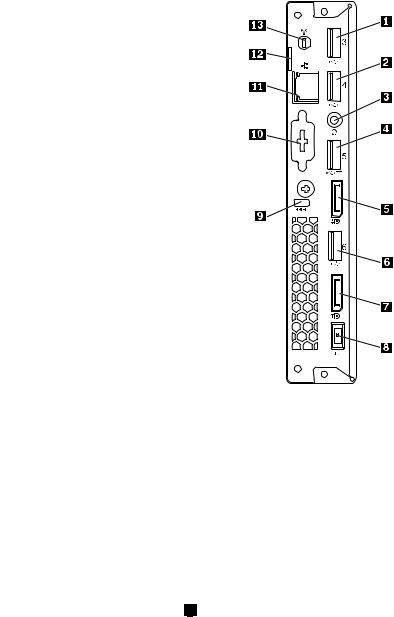
Rear view
Figure 2. Rear view
|
|
|
USB 3.0 connector |
|
|
|
USB 2.0 connector |
|
1 |
|
|
2 |
|
||
|
|
|
|
|
|
|
|
|
|
|
Headphone connector |
|
|
|
USB 2.0 connector |
|
3 |
|
|
4 |
|
||
|
|
|
|
|
|
|
|
|
|
|
DisplayPort® connector |
|
|
|
USB 3.0 connector |
|
5 |
|
|
6 |
|
||
|
|
|
|
|
|
|
|
|
|
|
DisplayPort connector |
|
|
|
Power adapter connector |
|
7 |
|
|
8 |
|
||
|
|
|
|
|
|
|
|
|
|
|
Security-lock slot |
|
|
|
Optional connector (available on some models) |
|
9 |
|
|
10 |
|
||
|
|
|
|
|
|
|
|
|
|
|
Ethernet connector |
|
|
|
Padlock loop |
|
11 |
|
|
12 |
|
||
|
|
|
|
|
|
|
|
|
|
|
Wi-Fi antenna slot |
|
|
|
|
|
13 |
|
|
|
|
|
|
|
|
|
|
|
|
|
|
Note: The USB 2.0 connector 4 supports the smart power on feature that enables you to turn on the computer or wake it up from S4 hibernation mode by pressing Alt+P on the keyboard. You can enable or disable the smart power on feature from the Setup Utility program. For detailed information, see “Enabling or disabling a device” on page 37.
•Power adapter connector
Used to connect the power adapter to your computer for power supply.
•DisplayPort connector
Used to connect a high-performance monitor, a direct-drive monitor, or other devices that use a DisplayPort connector.
Chapter 1. Product overview 3
•Ethernet connector
Used to connect an Ethernet cable for a local area network (LAN).
Note: To operate the computer within Federal Communications Commission (FCC) Class B limits, use a Category 5e or better Ethernet cable.
•Headphone connector
Used to connect headphones to your computer.
•Optional connector
Optional connector, depending on your computer model.
•Padlock loop
For information, see “Locking the computer cover” on page 31.
•Security-lock slot
For information, see “Attaching a Kensington-style cable lock” on page 33.
•USB 2.0 connector
Used to connect a device that requires a USB 2.0 connection, such as a keyboard, a mouse, a scanner, a printer, or a personal digital assistant (PDA).
•USB 3.0 connector
Used to connect a device that requires a USB 2.0 or USB 3.0 connection, such as a keyboard, a mouse, a scanner, a printer, or a PDA.
•Wi-Fi antenna slot
Used to install the rear Wi-Fi antenna cable connector that is available only on some models. The rear Wi-Fi antenna is installed on the rear Wi-Fi antenna cable connector.
4 ThinkCentre M600 User Guide
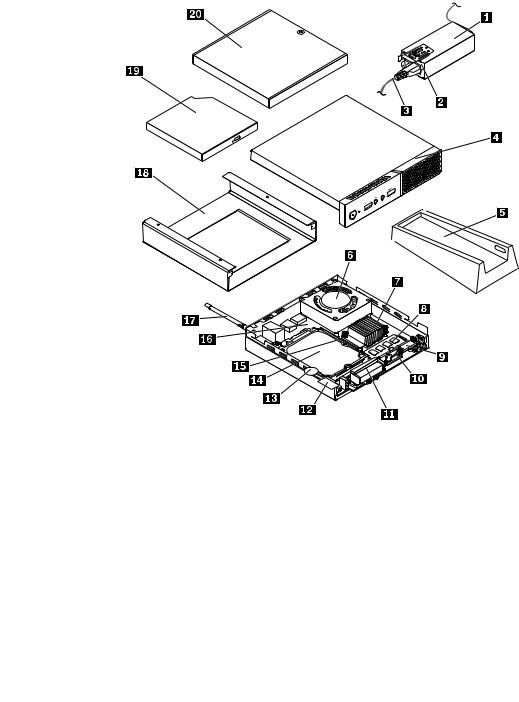
Computer components
Note: Depending on your computer model, some of the following components might not be available.
For 10G8, 10G9, 10GA, 10GB, 10GC, 10GD, 10GE, and 10GF
Figure 3. Computer components
|
|
|
Power adapter bracket |
|
|
|
Power adapter |
|
1 |
|
|
2 |
|
||
|
|
|
|
|
|
|
|
|
|
|
Power cord |
|
|
|
Computer cover |
|
3 |
|
|
4 |
|
||
|
|
|
|
|
|
|
|
|
|
|
Vertical stand |
|
|
|
System fan |
|
5 |
|
|
6 |
|
||
|
|
|
|
|
|
|
|
|
|
|
Heat sink |
|
|
|
Memory module |
|
7 |
|
|
8 |
|
||
|
|
|
|
|
|
|
|
|
|
|
Internal speaker holder |
|
|
|
Internal speaker |
|
9 |
|
|
10 |
|
||
|
|
|
|
|
|
|
|
|
|
|
Front Wi-Fi antenna |
|
|
|
Wi-Fi card |
|
11 |
|
|
12 |
|
||
|
|
|
|
|
|
||
|
|
|
Coin-cell battery |
|
|
|
2.5-inch storage drive |
|
13 |
|
|
14 |
|
||
|
|
|
|
|
|
||
|
|
|
Storage drive bracket |
|
|
|
System board |
|
15 |
|
|
16 |
|
||
|
|
|
|
|
|
||
|
|
|
Rear Wi-Fi antenna |
|
|
|
VESA® mount bracket |
|
17 |
|
|
18 |
|
||
|
|
|
|
|
|
||
|
|
|
External optical drive |
|
|
|
External box (external battery box, external optical |
|
19 |
|
|
20 |
|
||
|
|
|
|
|
drive box, or I/O box) |
||
|
|
|
|
|
|
|
|
Note: A 90-watt power adapter is required to ensure that the I/O box operates properly. A 90-watt power adapter is shipped with your computer or can be ordered separately. You are not recommended to use the I/O box that is offered with a ThinkCentre M53, M73, M83, or M93/p computer.
Chapter 1. Product overview 5
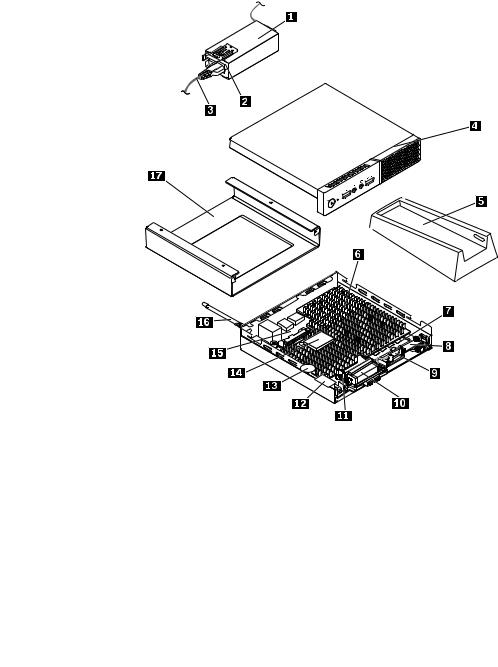
For 10KG, 10KH, 10KJ, and 10KK
Figure 4. Computer components
|
|
|
Power adapter bracket |
|
|
|
Power adapter |
|
1 |
|
|
2 |
|
||
|
|
|
|
|
|
|
|
|
|
|
Power cord |
|
|
|
Computer cover |
|
3 |
|
|
4 |
|
||
|
|
|
|
|
|
|
|
|
|
|
Vertical stand |
|
|
|
Heat sink |
|
5 |
|
|
6 |
|
||
|
|
|
|
|
|
|
|
|
|
|
Memory module |
|
|
|
Internal speaker holder |
|
7 |
|
|
8 |
|
||
|
|
|
|
|
|
|
|
|
|
|
Internal speaker |
|
|
|
Front Wi-Fi antenna |
|
9 |
|
|
10 |
|
||
|
|
|
|
|
|
|
|
|
|
|
Antenna bracket |
|
|
|
Wi-Fi card |
|
11 |
|
|
12 |
|
||
|
|
|
|
|
|
||
|
|
|
Coin-cell battery |
|
|
|
M.2 storage drivie |
|
13 |
|
|
14 |
|
||
|
|
|
|
|
|
||
|
|
|
System board |
|
|
|
Rear Wi-Fi antenna |
|
15 |
|
|
16 |
|
||
|
|
|
|
|
|
|
|
|
|
|
VESA mount bracket |
|
|
|
|
|
17 |
|
|
|
|
|
|
|
|
|
|
|
|
|
|
6 ThinkCentre M600 User Guide
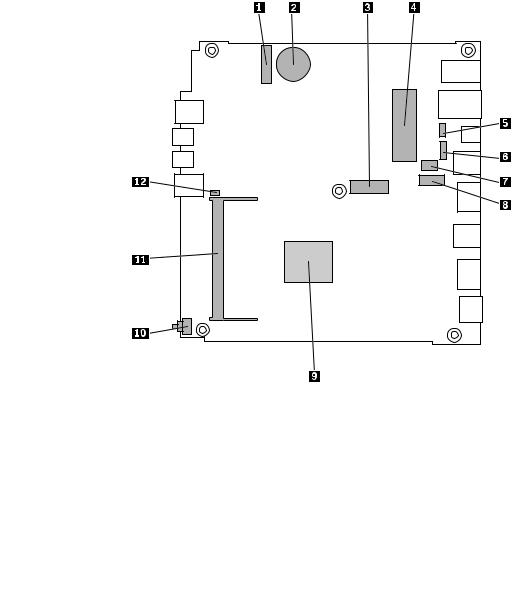
Parts on the system board
Note: For the parts that are displayed on the following figure but not introduced in the following table, see “Front view” on page 1 and “Rear view” on page 3.
Figure 5. Parts on the system board
|
|
|
|
|
M.2 Wi-Fi card slot |
|
|
|
Coin-cell battery |
|
|
1 |
|
|
|
2 |
|
||
|
|
|
|
|
|
|
|
||
|
|
|
|
|
M.2 storage drive slot (for 10KG, 10KH, 10KJ, and |
|
|
|
SATA 3.0 storage drive connector (for 10G8, 10G9, |
|
|
3 |
|
|
|
4 |
|
||
|
10KK) |
|
10GA, 10GB, 10GC, 10GD, 10GE, and 10GF) |
||||||
|
|
|
|
|
|
|
|
||
|
|
|
|
|
System fan connector (for 10G8, 10G9, 10GA, 10GB, |
|
|
|
Optional USB 2.0 connector |
|
|
5 |
|
|
|
6 |
|
||
|
10GC, 10GD, 10GE, and 10GF) |
|
|
|
|
||||
|
|
|
|
|
|
|
|
||
|
|
|
|
|
Optional serial connector |
|
|
|
Optional display connector |
|
|
7 |
|
|
|
8 |
|
||
|
|
|
|
|
|
|
|
||
|
|
|
|
|
Microprocessor |
|
|
|
Cover presence switch connector (Intrusion switch |
|
|
9 |
|
|
|
10 |
|
||
|
|
|
|
|
|
|
connector) |
||
|
|
|
|
|
|
|
|||
|
|
|
|
|
Memory slot |
|
|
|
Internal speaker connector |
|
|
11 |
|
|
12 |
|
|||
|
|
|
|
|
|
|
|
|
|
Chapter 1. Product overview 7

Machine type and model label
The machine type and model label identifies your computer. When you contact Lenovo for help, the machine type and model information helps support technicians to identify your computer and provide faster service.
The machine type and model label is attached on the side of your computer as shown.
Figure 6. Machine type and model label
Features
The computer features introduced in this section apply to various models.
Information about your computer
•To view basic information (such as microprocessor and memory information) about your computer, do the following:
1.Click the Start button to open the Start menu.
2.Depending on your Windows version, do one of the following:
–For Windows 7: Right-click Computer, and then click Properties.
–For Windows 10: Click Settings System About.
•To view detailed information about the devices (such as the optical drive and network adapters) on your computer, do the following:
8 ThinkCentre M600 User Guide
1.Depending on your Windows version, do one of the following:
–For Windows 7: Click the Start button to open the Start menu. Right-click Computer, and then click Properties.
–For Windows 10: Right-click the Start button to open the Start context menu.
2.Click Device Manager. Type the administrator password or provide confirmation if prompted.
Preinstalled operating system
Your computer is preinstalled with Windows 7 or Windows 10 operating system. Additional operating systems might be identified by Lenovo as compatible with your computer. To determine if an operating system has been certified or tested for compatibility, check the Web site of the operating system provider.
Note: Depending on your computer model, the information about Windows operating systems might not be applicable to your computer.
Power supply
Your computer comes with one of the following power adapters:
•65-watt power adapter
•90-watt power adapter
Storage drives
Your computer supports up to one storage drive (hard disk drives, hybrid drives, or solid-state drives).
To view the amount of storage drive space, do the following:
1.Depending on your Windows version, do one of the following:
•For Windows 7: Click the Start button to open the Start menu. Right-click Computer, and then click
Manage.
•For Windows 10: Right-click the Start button to open the Start context menu.
2.Click Disk Management.
Video features
The integrated graphics card supports the following display connectors on your computer:
• DisplayPort connectors
Audio features
The integrated audio card supports the following audio connectors and devices on your computer:
•Headphone connector
•Headset connector
•Internal speaker
•Microphone connector
Input/Output (I/O) features
•Audio connectors (headphone connector, headset connector, and microphone connector)
•DisplayPort connectors
•Ethernet connector
•USB connectors
Chapter 1. Product overview 9
Expansion
•External optical drive box (available on some models)
•Storage drive bay
•Memory slot
Network features
•Ethernet LAN
The integrated network interface card supports the Ethernet connector on your computer.
•Wireless LAN (available on some models)
•Bluetooth (available on some models)
Security features
For more information, see Chapter 4 “Security” on page 31.
System management features
•Ability to store power-on self-test (POST) hardware test results
•Desktop Management Interface (DMI)
Desktop Management Interface provides a common path for users to access information about all aspects of a computer. The information includes processor type, installation date, connected printers and other peripherals, power sources, maintenance history, and so on.
•ErP LPS compliance mode
The energy-related products directive (ErP) lowest power state (LPS) compliance mode reduces the consumption of electricity when your computer is in sleep or off mode. For more information, see “Enabling or disabling ErP LPS compliance mode” on page 38.
•Preboot Execution Environment (PXE)
Preboot Execution Environment enables computers to start through a network interface independent of data storage drives (such as hard disk drives) or installed operating systems.
•System Management (SM) Basic Input/Output System (BIOS) and SM software
The SMBIOS specification defines data structures and access methods that can be used to read management data stored in the BIOS of a computer.
•Wake on LAN
Wake on LAN is an Ethernet computer networking standard that allows a computer to be turned on or woken up by a network message. The message usually is sent by a program running on another computer on the same LAN.
•Wake on Ring
Wake on Ring, sometimes referred to as Wake on Modem, is a specification that allows supported computers and devices to resume from sleep or hibernation mode.
•Windows Management Instrumentation (WMI)
Windows Management Instrumentation is a set of extensions to the Windows Driver Model. It provides an operating system interface through which instrumented components provide information and notification.
10 ThinkCentre M600 User Guide

Specifications
This section lists the physical specifications for your computer.
Dimensions
Width: 35 mm (1.4 inches)
Height: 179 mm (7.0 inches)
Depth: 182 mm (7.2 inches)
Weight
Maximum configuration as shipped: 1.3 kg (2.9 lb)
Environment
• Air temperature:
Operating: From 10°C (50°F) to 35°C (95°F)
Storage in original shipping package: From -40°C (-40°F) to 60°C (140°F)
Storage without package: From -10°C (14°F) to 60°C (140°F)
• Humidity:
Operating: 20%–80% (non-condensing)
Storage: 20%–90% (non-condensing)
• Altitude:
Operating: From -15.2 m (-50 ft) to 3048 m (10 000 ft)
Storage: From -15.2 m (-50 ft) to 10 668 m (35 000 ft)
Electrical input
Input voltage: From 100 V ac to 240 V ac
Input frequency: 50/60 Hz
Programs
This section provides information about the programs on your computer.
Accessing a program on your computer
Note: For Windows 7, depending on your computer model, some of the Lenovo programs might be ready to be installed, so you need to install them manually. Then, you can access and use these programs.
To access a program on your computer, do one of the following:
•From Windows Search:
1.Depending on your Windows version, do one of the following:
–For Windows 7: Click the Start button to open the Start menu, and then type the program name into the search box.
–For Windows 10: Type the program name into the search box next to the Start button.
2.In the search results, click the name of the desired program to launch the program.
•From the Start menu or Control Panel:
1.Click the Start button to open the Start menu. Then, click the name of the desired program to launch the program.
Chapter 1. Product overview 11
2.If the program name is not displayed, click All Programs for Windows 7 or All apps for Windows 10 to display the program list. From the list or a folder in the list, click the name of the desired program to launch the program.
3.If the program name is not displayed on the Start menu, access the program from Control Panel.
a.Depending on your Windows version, do one of the following:
–For Windows 7: Click Control Panel on the Start menu.
–For Windows 10: Right-click the Start button to open the Start context menu, and then click
Control Panel.
b.View Control Panel using Large icons or Small icons, and then click the name of the desired program to launch the program.
Installing a program that is ready to be installed
To install a program that is ready to be installed, do the following:
1.Open the Lenovo ThinkVantage® Tools program. See “Accessing a program on your computer” on page 11.
2.View the program icons using Tiles.
3.Follow the instructions under greyed-out icons to locate the icon for the desired program. Then, double-click the icon to install the program.
An introduction to Lenovo programs
This section provides information about the major Lenovo programs available on your operating system.
Note: Depending on your computer model, some of the following programs might not be available.
•For Windows 7 only:
–Create Recovery Media
The Create Recovery Media program enables you to restore only the C drive or the entire storage drive to the factory-default settings.
–Fingerprint Manager Pro or ThinkVantage Fingerprint Software
The Fingerprint Manager Pro or ThinkVantage Fingerprint Software program enables you to use a fingerprint reader. The integrated fingerprint reader provided on some keyboards enables you to enroll your fingerprint and associate it with your power-on password, hard disk password, and Windows password. As a result, fingerprint authentication can replace passwords and enable simple and secure user access.
–Lenovo PowerENGAGE
The Lenovo PowerENGAGE program enables you to register your computer with Lenovo.
–Password Manager
The Password Manager program automatically captures and fills in authentication information for Windows programs and Web sites.
–Rescue and Recovery®
The Rescue and Recovery program is a one-button recovery and restore solution. It includes a set of self-recovery tools to help you diagnose computer problems, get help, and recover from system crashes, even if you cannot start the Windows operating system.
12 ThinkCentre M600 User Guide
–System Update
The System Update program provides regular access to the system updates for your computer, such as device driver updates, software updates, and BIOS updates. The program gathers information from the Lenovo Help Center about new updates for your computer, then sorts and displays the updates for download and installation. You have complete control of which updates to download and install.
•For Windows 10 only:
–Lenovo Companion
Your computer’s best features and capabilities should be easy to access and understand. With Lenovo Companion, they are. Use Lenovo Companion to do the following:
–Optimize your computer’s performance, monitor your computer’s health, and manage updates.
–Access your user guide, check warranty status, and view accessories customized for your computer.
–Read how-to articles, explore Lenovo forums, and stay up-to-date on technology news with articles and blogs from trusted sources.
Lenovo Companion is filled with exclusive Lenovo content to help you learn more about what you can do with your computer.
–Lenovo ID
The Lenovo ID program enables you to create your Lenovo ID and access all supported Lenovo programs and web portals with single sign-on.
•For Windows 7 and Windows 10:
–Lenovo Bluetooth Lock
The Lenovo Bluetooth Lock program enables you to use a Bluetooth device (such as your smartphone) as a proximity-based unit for locking or unlocking your computer automatically. By detecting the distance between your computer and the predefined Bluetooth device that you are carrying, the Lenovo Bluetooth Lock program automatically locks your computer when you walk away and unlocks your computer when you come back. This is a simple way to protect your computer against unauthorized access in case that you forget to lock your computer.
–Lenovo Device Experience or Lenovo PC Experience
The Lenovo Device Experience or Lenovo PC Experience program helps you work more easily and securely. The program provides easy access to Lenovo ThinkVantage Tools or Lenovo Tools, important settings and information about your computer, the Lenovo Support Web site, and so on.
–Lenovo Solution Center
The Lenovo Solution Center program enables you to troubleshoot and resolve computer problems. It combines diagnostic tests, system information collection, security status, and support information, along with hints and tips for maximum system performance.
–Power Manager
The Power Manager program provides convenient, flexible, and complete power management for your computer. It enables you to adjust your computer power settings to achieve the best balance between performance and power saving.
Chapter 1. Product overview 13
14 ThinkCentre M600 User Guide

Chapter 2. Using your computer
This chapter contains the following topics:
•“Registering your computer” on page 15
•“Setting the computer volume” on page 15
•“Adding an icon to the Windows notification area” on page 15
•“Using a disc” on page 16
•“Connecting to a network” on page 17
•“I/O box” on page 18
•“External battery box” on page 19
Registering your computer
When you register your computer with Lenovo, you enter required information into a Lenovo database. The information enables Lenovo to contact you when there is a recall or other severe problem and provide quicker service when you call Lenovo for help. In addition, some locations offer extended privileges and services to registered users.
To register your computer with Lenovo, ensure that your computer is connected to the Internet. Then, go to http://www.lenovo.com/register and follow the instructions on the screen.
Setting the computer volume
To set the computer volume, do the following:
1.Click the volume icon in the Windows notification area on the taskbar.
Note: If the volume icon is not displayed in the Windows notification area, add the icon to the notification area. See “Adding an icon to the Windows notification area” on page 15.
2.Follow the instructions on the screen to adjust the volume. Click the speaker icon to mute the audio.
Adding an icon to the Windows notification area
To add an icon to the Windows notification area, do the following:
1.Click the arrow next to the notification area to view hidden icons. Then, click the desired icon and drag it to the notification area.
2.If the icon is not displayed, turn on the icon.
a.Click the Start button to open the Start menu.
b.Depending on your Windows version, do one of the following:
•For Windows 7: Click Control Panel. View Control Panel using Large icons or Small icons, and then click Notification Area Icons Turn system icons on or off.
•For Windows 10: Click Settings System Notifications & actions Turn system icons on or off.
c.Turn on the desired icon.
3.If the icon is still not displayed in the Windows notification area, repeat step 1.
© Copyright Lenovo 2015, 2016 |
15 |

Using a disc
This section provides information about using a disc and the optical drive.
Guidelines about using the optical drive
When using the optical drive, follow these guidelines:
•Do not place the computer in a location where the drive is exposed to any of the following conditions:
–High temperature
–High humidity
–Excessive dust
–Excessive vibration or sudden shock
–An inclined surface
–Direct sunlight
•Do not insert any object other than a disc into the drive.
•Do not insert damaged discs into the drive. Warped, scratched, or dirty discs can damage the drive.
•Before moving the computer, remove the disc from the drive.
Handling and storing a disc
When handling and storing a disc, follow these guidelines:
•Hold the disc by its edges. Do not touch the surface of the side that is not labeled.
•To remove dust or fingerprints, wipe the disc with a clean, soft cloth from the center to the outside. Wiping the disc in a circular direction might cause loss of data.
•Do not write or stick paper on the disc.
•Do not scratch or mark the disc.
•Do not place or store the disc in direct sunlight.
•Do not use benzene, thinners, or other cleaners to clean the disc.
•Do not drop or bend the disc.
Playing and removing a disc
To play a disc, do the following:
1.With the computer on, press the eject/close button on the front of the optical drive. The tray slides out of the drive.
2.Insert a disc into the tray. Some optical drive has a snap hub in the center of the tray. If your drive has a snap hub, support the tray with one hand and then push center of the disc until it snaps into place.
3.Press the eject/close button again or gently push the tray forward to close the tray. The disc player program starts automatically. For more information, refer to the help system of the disc player program.
To remove a disc from the optical drive, do the following:
1.With the computer on, press the eject/close button on the front of the optical drive. The tray slides out of the drive.
2.Carefully remove the disc from the tray.
3.Press the eject/close button again or gently push the tray forward to close the tray.
16 ThinkCentre M600 User Guide

Note: If the tray does not slide out of the drive when you press the eject/close button, turn off your computer. Then, insert a straightened paper clip into the emergency-eject hole adjacent to the eject/close button. Use the emergency eject only in an emergency.
Recording a disc
If your optical drive supports recording, you can record a disc.
Recording a disc using Windows tools
To record a disc using Windows tools, do one of the following:
•Burn a disc using the AutoPlay window.
1.Ensure that the disc is played automatically.
a.Click the Start button to open the Start menu.
b.Depending on your Windows version, do one of the following:
–For Windows 7: Click Control Panel. View Control Panel using Large icons or Small icons, and then click AutoPlay.
–For Windows 10: Click Settings Devices AutoPlay.
c.Select or turn on Use AutoPlay for all media and devices.
2.Insert a recordable disc into the optical drive that supports recording. The AutoPlay window opens.
3.Follow the instructions on the screen.
•Burn a disc using Windows Media® Player.
1.Insert a recordable disc into the optical drive that supports recording.
2.Open Windows Media Player. See “Accessing a program on your computer” on page 11.
3.Follow the instructions on the screen.
•Burn a disc from an ISO file.
1.Insert a recordable disc into the optical drive that supports recording.
2.Double-click the ISO file.
3.Follow the instructions on the screen.
Recording a disc using preinstalled programs
To record a disc using preinstalled programs, do the following:
1.Insert a recordable disc into the optical drive that supports recording.
2.Open the PowerDVD Create, PowerProducer, or Power2Go program. See “Accessing a program on your computer” on page 11.
3.Follow the instructions on the screen.
Connecting to a network
This section provides information about connecting to a network. If you cannot connect your computer to a network, see “Networking problems” on page 47.
Connecting to an Ethernet LAN
You can connect your computer to an Ethernet LAN by connecting an Ethernet cable to the Ethernet connector.
Chapter 2. Using your computer 17

 DANGER
DANGER
To avoid the risk of electrical shock, do not connect the telephone cable to the Ethernet connector.
Connecting to a wireless LAN
You can connect your computer to a wireless LAN without the use of an Ethernet cable but by means of radio waves only.
Note: The wireless LAN feature is supported only on some models.
To establish a wireless-LAN connection, do the following:
1.Ensure that a wireless LAN is available and the wireless LAN feature on your computer is working.
2.Click the wireless-network-connection-status icon in the Windows notification area to display available wireless networks.
Note: If the wireless-network-connection-status icon is not displayed in the Windows notification area, add the icon to the notification area. See “Adding an icon to the Windows notification area” on page 15.
3.Click a wireless LAN, and then click Connect to connect your computer to it. Provide required information if needed.
Connecting to a Bluetooth-enabled device
Bluetooth is a short-range wireless communications technology. Use Bluetooth to establish a wireless connection between your computer and another Bluetooth-enabled device within a distance of about 10 m (32.8 ft).
Note: The Bluetooth feature is supported only on some models.
To connect to a Bluetooth-enabled device, do the following:
1.Ensure that the Bluetooth feature on your computer is working and the Bluetooth-enabled device is located within a distance of about 10 m (32.8 ft) from your computer.
2.Click the Bluetooth icon in the Windows notification area on the taskbar. Then, click Add a Device and follow the instructions on the screen.
Note: If the Bluetooth icon is not displayed in the Windows notification area, add the icon to the notification area. See “Adding an icon to the Windows notification area” on page 15.
I/O box
This section provides the following information:
•“About the I/O box” on page 18
•“Using the I/O box” on page 19
Note: For information about replacing the I/O box, refer to “Replacing the I/O box (for 10G8, 10G9, 10GA, 10GB, 10GC, 10GD, 10GE, and 10GF)” on page 67.
About the I/O box
The I/O box provides the following connectors:
• For connecting to the ThinkCentre® tiny personal computer
One USB 3.0 connector
18 ThinkCentre M600 User Guide

• For connecting to external devices
Four USB 2.0 connectors (two on the front and two on the rear)
Two USB 3.0 connectors
One serial port
Dimensions
Width: 24 mm (0.9 inches)
Height: 183 mm (7.2 inches)
Depth: 184 mm (7.2 inches)
Using the I/O box
When you use the I/O box with the ThinkCentre tiny computer, note the following:
•The I/O box supports a maximum current rating of 5 A. It is recommended that you connect low-current devices to the I/O box and connect high-current devices directly to the ThinkCentre tiny computer to ensure the best performance of the devices.
•The USB 2.0 connectors and USB 3.0 connectors on the I/O box each provides 500 mA and 900mA current, respectively. When you connect a high-current storage drive to only one USB connector, the system might not recognize the device. You can connect the storage drive to two USB connectors on the I/O box.
•The serial port does not support hot swapping. Do not connect a device to the connector or remove a device from the connector while the system is running.
•The connectors on the I/O box cannot be enabled or disabled individually. To enable or disable any of the connectors on the I/O box, enable or disable the USB connectors 3 and 4 on the rear of the computer.
•The I/O box enables you to wake up the computer from S3 standby mode through operations on devices connected to the I/O box connectors.
External battery box
This section provides the following information:
•“Battery safety information” on page 19
•“Using the external battery kit” on page 20
Note: For information about replacing the external battery box, refer to “Replacing the external battery box (for 10G8, 10G9, 10GA, 10GB, 10GC, 10GD, 10GE, and 10GF)” on page 70.
Battery safety information
http://www.lenovo.com/safety
Chapter 2. Using your computer 19

Safety information
 DANGER
DANGER
There is a danger of explosion if the rechargeable battery pack is incorrectly replaced. The battery pack contains a small amount of harmful substances.
To avoid possible injury:
•Replace only with a battery of the type recommended by Lenovo.
•Keep the battery pack away from fire.
•Do not expose it to water or rain.
•Do not attempt to disassemble it.
•Do not short-circuit it.
•Keep it away from children.
Note: (JEITA guidance): Batteries are expendable products. When a fully charged battery no longer provides sufficient run time, it should be replaced. Batteries used longer than the warranty period may be good candidates for replacement. Battery replacements under warranty must be validated by Lenovo using Lenovo system diagnostics installed on the computer, or available for
download at www.lenovo.com/thinkvantagetoolbox and either www.lenovo.com/powermanager_xp or www.lenovo.com/powermanager_vista_win7. Battery life is affected by several factors such as recharge cycle count, temperature, system usage, screen brightness, applications, and other customer preferences.
Note: Lenovo batteries are shipped partially charged to maximize shelf life. To maximize the longevity of your battery, you should fully charge it after receiving it. Batteries should also be recharged at least twice a year. If the battery is stored with a low charge for extended periods of time, the battery may become unusable and might be disabled.Batteries supplied by Lenovo for use with your product have been tested for compatibility and should only be replaced with approved parts.
A battery pack other than the one specified by Lenovo, or a disassembled or modified battery pack is not covered by the warranty.
Lenovo does not support batteries that are not genuine Lenovo-made or authorized. Lenovo systems may continue to boot, but may not charge unauthorized batteries.
Warning: Lenovo has no responsibility for the performance or safety of unauthorized batteries, and provides no warranties for failures or damage arising out of their use.
Using the external battery kit
Prerequisites
•The external battery kit is connected to a Lenovo-specified power adapter with the following electrical parameters:
Input: 100-240 V ac Output: 20 V dc, 3.25 A
•The external battery kit is used and stored in the following environment temperature: 10°C to 40°C (50°F to 104°F)
20 ThinkCentre M600 User Guide
